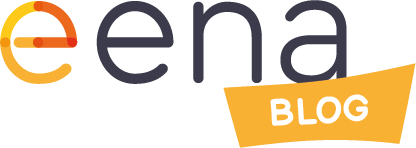EENA meets Mher Hakobyan from EDF
In May 2021, Marta Azevedo Silva, EENA’s Communication & Press Officer, sat down with Mher Hakobyan, Accessibility Officer at the European Disability Forum, to have an informal conversation about inclusion, EU policy, best practices in European countries and what can be done to make these citizens safer.
Maybe not today but at some point in our lives, we will need accessibility in one way or another. So, we should start thinking with the mindset that accessibility is essential for all of us!
Could you tell me a little bit about your role at the European Disability Forum?
“I work as an accessibility officer at the European Disability Forum (EDF). Just a brief introduction to the European Disability Forum (EDF) – we are an independent NGO that represents the interests of 100 million Europeans with disabilities. Our network brings together representative organisations of persons with disabilities from across Europe. We are run by persons with disabilities and their families. The main part of our work is advocacy towards the EU and Member States for the full implementation of the UN Convention on the Rights of Persons with Disabilities (UN CRPD). Accessibility is one of the rights enshrined in the Convention (article 9). So, my work includes advocacy and awareness-raising on accessibility for persons with disabilities in various domains, including access to transport (this also includes passenger rights), built environment, as well as digital services and products. Within the latter, I also focus on accessibility of electronic, including emergency communications. Lastly, I am also involved in standardisation work which supports EU accessibility policy objectives.“

What is needed to ensure an equivalent access to emergency services?
“We have issued recommendations on ensuring equal access and choice to electronic communications services, including emergency communications, by persons with disabilities, as well as detailed ways of ensuring this in Section 2.12 of our toolkit on the transposition of the European Electronic Communications Code. Briefly, to ensure equivalent access to emergency services we recommend that:
- Public Safety Answering Points (PSAPs) for the single European emergency number ‘112’ comply with the accessibility and interoperability requirements of the European Accessibility Act for Public Safety Answering Points, responding to emergency calls by real-time text and total conversation services. Missing children (116000) and child helpline (116111) hotlines and national emergency numbers should use the same requirements.
- Public warning systems and emergency information are accessible through more than one sensory channel (for example text and audio) and easy to understand (not exceeding a level of complexity superior to level B1 of the Council of Europe’s Common European Framework of Reference for Languages).
- Advanced Mobile Location (AML) systems for calls and text to the single European emergency number ‘112’ and national emergency numbers are deployed effectively and without undue delays, as these will allow the person making the emergency call to be located quickly, which is crucial in emergency response.
- Next Generation ‘112’ are deployed to enable high quality accessible emergency communication using real-time-text and total conversation services over internet protocol.
- Countries should also remove unhelpful administrative (e.g. requirement to pre-register in order to be able to access emergency services) and cost barriers (e.g. when roaming) so that freedom of movement of persons with disabilities is ensured, as well as their safety when they travel within the EU.
“Now, EU countries are in the process of transposing the European Accessibility Act. They should do this with the greatest ambition and effectiveness so that emergency communications become accessible for persons with disabilities as soon as possible. For example, most of the measures of the Act are to be applied from June 2025, but for emergency communications, countries have until June 2027 to apply the measures. Accessibility of something as urgent as emergency communication should not be delayed, so we urge Member States to ensure accessibility sooner than legally required by the Act.“

The primary way of communicating with emergency services is via voice call, which makes it more difficult for persons with disabilities to alert emergency services when in danger. How is the European Union addressing this gap?
“The EU is addressing this gap through legislation which aims to ensure equal access and harmonise level of rights and accessibility across Member States. At the moment, the picture is quite fragmented from country to country, and even within countries there can be differences in the way emergency services are provided and how accessible they are (or often not). Two main EU laws relevant for solving accessibility of emergency communications are, as you know, the European Electronic Communications Code (EECC) and the European Accessibility Act. The Code states that countries must ensure that end-users with disabilities have access to emergency communications equivalent to other end-users in accordance with the European Accessibility Act. And the Act addressed the accessibility requirements in Annex I Section V. Here it details specific accessibility requirements related to the answering of emergency communications to the single European emergency number ‘112’ by the most appropriate PSAP:
- including functions, practices, policies and procedures and alterations targeted to address the needs of persons with disabilities
- that emergency communications to the single European emergency number ‘112’ are appropriately answered by the most appropriate PSAP using the same communication means as received, namely by using synchronised voice and text (including real time text), or, where video is provided, voice, text (including real time text) and video synchronised as total conversation.
Based on the requirements of Annex I, the European Commission will request European standards and will adopt technical specifications that will provide further technical details on how to meet these requirements.“

The recent European Electronic Communications Code (EECC) clarifies that access to end-users with disabilities must be available through “emergency communications” instead of “emergency calls”. Could you explain the importance of this change of vocabulary?
“Yes, as you note this is important. Understandably, many people, including but not limited to hard of hearing persons, deaf persons, persons with speech impediments, etc. will require other ways of communication than voice-communication. Here again, real-time-text and total conversation technologies are crucial. Relay services as well, but of course it is always more effective and quicker if a person in need of emergency assistance can communicate with the PSAP directly rather than through an intermediary relay service.“
It is commonly said that accessibility is essential for some but useful for all. What is your view on this statement?
“I would agree to an extent, and this is often what we highlight. However, my personal opinion on this type of messaging is that it can also be counter-productive. When we highlight that accessibility is essential for “some” by which of course we mainly mean persons with disabilities, I think there is a risk of ‘othering’ persons with disabilities and inevitably implying that accessibility is really not that important unless you are directly affected by it. I think we need a change of paradigm among policy-makers, technology developers and service providers (and maybe among ourselves too) that persons with disabilities are not a specific separate group needing specific solutions and support. If we look more closely, we will find persons with disabilities among our family members, friends and each of us are or can be(come) a person with disability and require accessibility. Now we are an estimated 100 million in the EU. That is 20% or 1/5 of EU’s population, and this number is predicted to grow significantly. Add to that more than 100 million older persons and our ageing societies and you see that we are talking about ourselves – all of us and not others – a relatively small group of people. Maybe not today, but at some point in our lives, we will need accessibility in one way or another. So, we should start thinking with the mindset that accessibility is essential for all of us!“

Could the improvements in access to emergency services also be of benefit to other vulnerable groups (e.g., older persons, children, pregnant women)?
“As already clear my answer is yes! In fact, as UN CRPD notes, we should have a ‘design for all’ approach to accessibility with the idea that it benefits as wide a group of persons as possible. Besides technical access, there are also other barriers which limit the access of some persons to communications services, including for contacting emergency services. Here we can highlight for example cost barriers to digital products or services which are used to communicate with emergency services. For example, if you cannot afford a smartphone or mobile/internet subscription, your ability to reach emergency services is not at an equal level to a person who can afford these things, so socio-economic status is a ground to consider. Other ‘groups’ might face barriers due to insufficient IT literacy. If you are a person with disability who is also struggling financially (which is not rare), you can face double barriers related to accessibility and affordability. So, an intersectional and holistic approach is necessary when trying to find policy and technological solutions.”
The COVID-19 outbreak has made persons with disabilities face even greater inequalities in accessing emergency services. Is it possible to quantify the impact of the pandemic on persons with disabilities?
“We have very recently published our human rights report focusing on the impact of COVID-19 on persons with disabilities. It highlights how the EU and European countries have largely failed to include persons with disabilities in their response to the pandemic, both within Europe and in their global response.
Despite existing EU legislation obliging Member States to ensure accessible emergency information, emergency communications and public warning systems, the lack of accessibility of important public health announcements and national emergency measures were the first important gaps in national pandemic responses.
But thanks to the efforts and strong advocacy of national disability organisations, some countries improved things after the initial shock in the first weeks of lockdowns. For example, video service helplines for Deaf users were provided in France, Poland, and the United Kingdom. In France, it was a teleservice to provide assistance and answer questions for Deaf and hard of hearing people; in Poland, a video helpline through a partnership with the Polish Association for the Deaf; and in the United Kingdom, a video service for those claiming Universal Credit. Some countries, including Bulgaria, offered helplines for psychological support. Sometimes these were for the general population, however, the Bulgarian helpline was targeted at older persons and persons with disabilities.
COVID-19 clearly demonstrated that the systems in place are not sufficient to ensure effective response to crises and even less so for persons more vulnerable to risk, including persons with disabilities. We hope, despite the many grievances the pandemic has brought, it has also been a learning opportunity for EU and member countries to improve accessibility and ensure future policies and measures are disability-inclusive.”
[1] https://www.worldbank.org/en/topic/disability
Author: Marta Azevedo Silva, Former Communications and Press Manager at EENA
The opinions expressed are those of the author and do not necessarily represent the views of EENA. Articles do not represent an endorsement by EENA of any organisation.

EENA
- EENA#molongui-disabled-link
- EENA#molongui-disabled-link
- EENA#molongui-disabled-link
- EENA#molongui-disabled-link
Share this blog post on:
